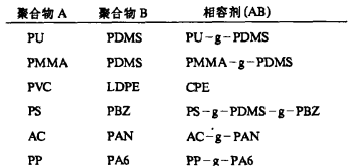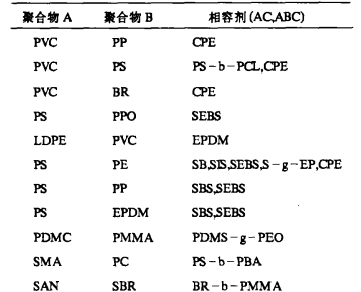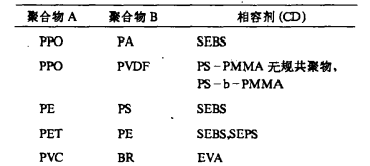A polymer alloy is created by mixing several resins, and it frequently possesses qualities that a single resin cannot match or even lacks, considerably expanding the range of uses for materials.
However, because various resins have very varying polar properties, it might be challenging to combine them into a homogenous solution. How therefore may polymer alloy compatibility be increased to produce polymer alloy products that are useful?
A succinct description of the compatibilizer
1.How do compatibilizers work?
The compatibility of polymer alloys may be increased in a number of ways. The simplest method is to combine the two polymers with a third element, known as a compatibilizer, to strengthen their interfacial cohesion and create a stable blend structure that will boost compatibility and enhance the mechanical characteristics of the polymer alloy.
a compatibilizer's schematic design for blending an incompatible substance
2. Compatibilizer classification

3. The compatibilizer's mode of operation
1. During the polymer blending process, it is enriched as a surfactant at the polymer's two-phase interface, creating a "bridge" between the two phases of the polymer in a manner akin to an emulsifier or increasing the surface area of the polymer. The interfacial tension is decreased when the solvent emulsifies or interacts with the two-phase polymer, causing them to entangle with one another.
2. Enhance the dispersibility of the dispersed phase in the matrix, finen and more evenly scatter the dispersed phase's particles inside the matrix, and increase the stability of the dispersed phase and matrix structures to enhance the mechanical characteristics of the polymer blend.
3. Make the bond between the dispersed phase and the continuous phase stronger, increase the adhesion ability of the two phases of the blend, and increase the thickness of the polymer two-phase interface layer, so that initially incompatible two phases become blends that can withstand processing.
The addition of different compatibilizer
First, a reactive compatibilizer
In order to create covalent bonds during blending and a strong adhesion between the polymer components, the reactive compatibilizer comprises groups that can chemically react with the blend's constituents. to provide the effect of increased capacity. Four categories exist:
(1) Type of 無水マレイン酸
The maleic anhydride type compatibilizer, which often results from the graft polymerization of maleic anhydride and a certain polymer, is a carboxyl-containing compatibilizer.
(2) Type acrylic
The maleic anhydride type compatibilizer, which often results from the graft polymerization of acrylic acid and a certain polymer, is also a carboxyl-containing compatibilizer.

(3) Type epoxy
Epoxy compatibilizers are end-group compatibilizers for epoxy compounds.

(4) Compatible reactive polymer
Some polymers themselves have chemically reactive groups that, when combined with another substance, can react and show self-compatibility.
2.A compatibilizer that is non-reactive
Non-reactive compatibilizers are those that do not interact chemically with the blend components and instead rely on their affinities with each component to strengthen the bonding of the blend system's constituent parts. Three categories exist:
(1) A compatibilizer of type AB
Block or graft copolymerization is used to create two component polymers with A and B.

(2) A compatible AC (ABC) type
It is created by the block or graft copolymerization of two (or three) monomers or polymers of AC (ABC), with C being partly or miscibly compatible with B.

(3) A compatibilizer for CDs
A compatibilizer for small molecules
Nearly all reactive small molecule compatibilizers, such those in the common silicon family, may either chemically react with both components or have strong compatibility with only one of them.
3. The role and use of compatibilizer
(1).Highlight the alloy's strong performance
Under normal processing conditions, the majority of incompatible systems have a "sea-island" structure, where the dispersed phase polymer is disseminated in the continuous phase polymer matrix as particles (or rods or ellipsoids).
However, the compatibilizer promotes the two phases' finer and more uniform dispersion while lowering their interfacial tension and maintaining a stable submicron shape. The performance of the system that had no prior application value may be improved by choosing the kind, dose, and appropriate processing conditions of the compatibilizer and controlling the particle size and distribution of the dispersed phase to obtain the optimal state.
(2)Encourage alloy functionalization
A polymer alloy having unique features including biodegradability, gas barrier qualities, and persistent antistatic properties is referred to as a functional polymer alloy. By using a compatibilizer, it is possible to create high-quality polymer alloys with dispersed phase layering, dispersed phase fibrosis, and interpenetrating network structures in addition to the typical high-quality "island" structure. This allows for the realization of numerous exceptional functions that are not possible with the "sea island" structure, as well as the creation of high-functional polymer alloys with various functions.
(3)Recycling old plastic bottles
How to handle mixed waste plastics is the biggest challenge in the recycling of waste plastics. The societal and economic advantages will be substantial if it is able to regenerate such materials into high-performance new polymer alloys utilizing compatible technology and melt blending technology without specific treatment.













